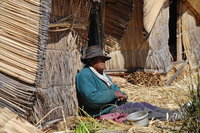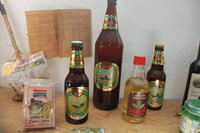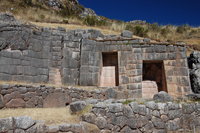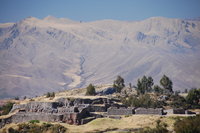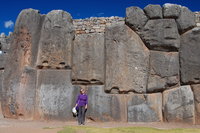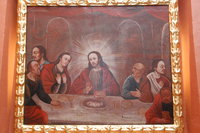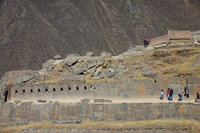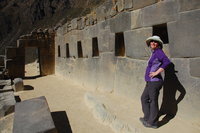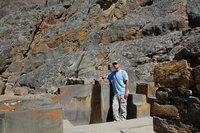The crossing from Bolivia into Peru occurred without too much trouble. We were stopped by the army just before leaving Bolivia to check that the bus did not have too much fuel on board. It is not clear whether they thought we might sell it to the Peruvians or whether the bus might try to bring extra fuel back. Either way, that bus must do that trip every day so you would think they would avoid any fuel related antics. We had to pass through Bolivian emigration then walk across no-man's land in the usual manner to the Peruvian immigration.
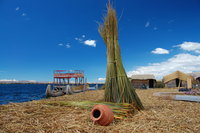
Like Copacabana, Puno sits on the shores of Lago Titcaca. Also like Copacabana, it is a bit of a dump. Actually, it is a lot of a dump. Its only claim to fame is that it is where you catch a boat to go and point cameras at the local indigenous folk who live on the floating reed islands and row around in the reed boats. There really is no need to feel guilty about invading any precious cultural remnants, these guys have the tourist scene sewn up. Each island seems to be home to an extended family and when the tourist boat arrives, the family elder gives a well practised lecture about the way the islanders live(d) and the way they build their islands, etc. The talk is very entertaining and informative so it doesn't matter that this is not really the real thing. Apparently, there are some people who still live the authentic life, but they don't want to be visited; which is fair enough. These guys claim to live on fish and birds that they catch, but looking at the size of them, there's more Inca cola and burger in their diet than they would care to admit. after the talk, we were rowed around some of the islands in a reed boat (with the underlying plastic showing in places). Knowing something about boats, we observed the prevailing wind and the fitness of the people rowing and predicted that we would be heading in the direction of Bolivia. Sure enough, we cast off and, amid vigorous rowing, we drifted down the lake. Soon however, a small motor boat appeared and started pushing us upwind. The vigorous rowing continued! We were given plenty of opportunity to buy local crafts that had been produced on the islands (honest!).
It was an interesting visit and worth stopping off in Puno to see. We had expected to leave all the protest and blockade shinanegins behind as we left Bolivia, but this was not to be. There were frequent parades and protest marches throughout Puno during our time there. At one point we were sitting in a café listening to the chanting and drumming when suddenly there was a lot of screaming. The police started running past the doors to the café shouting for them to be closed. The staff, in a well practised routine appeared and locked us in before the aggressive rabble ran past. At another point, we were walking towards the Lan Peru office to ask about flights when they pulled the shutters down and locked the doors. Unlucky for it to be closing just as we arrived, we thought. Not so, as another rabble, this time protesting students ran past. We had planned to take a morning bus to Cusco, but found that a 48 hour protest down the road meant we couldn't leave. Rather conveniently, the protesters only come out during the day, so we sat around in Puno all day before catching a night bus. Unfortunately the journey was only six hours so we ended up in Cusco bus station at 4:30am with nowhere to go.
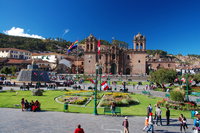
We are slowly heading towards Machu Picchu and Cusco is a place Megan had always wanted to visit, so we were hoping that (unlike Puno) it might turn out to be quite nice. We were not to be disappointed! Cusco was the epicentre of the Inca civilization and bears the marks of this today. There are many narrow streets lined with stone blocks hewn in the characteristically accurate Inca style. Of course, being such an important Inca site means that it became an important colonial site too and there is plenty of this architecture superimposed. The town has a large open square and many cobbled streets. It does not seem to suffer from the traffic problems and pollution that plagued even the nicest of Bolivian cities. We spent a pleasant couple of days here sampling the cafés. There is a large quotient of gringos here and we were surprised to be asked by a few of them how we were coping with the altitude. Now, Cusco sits at 3300m and, if you've been following us this far, you will know that this is practically sea level for us. Certainly, the air tastes thicker this "low down"! We realised that, as we draw nearer to Machu Picchu, we are now meeting package tourists who have flown into Lima (on the coast) and then immediately up to Cusco. For them, 3300m is a real problem. For us, it's the lowest we've been in six weeks!
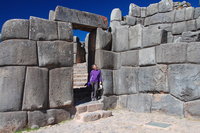
Whilst in Cusco, we made a day trip out to take a look at our first real Inca ruins. There are four sites outside town and we took a taxi to the furthest and walked back. The sites are Tambo Machay, Puca Pucara, Quenco and Sacsayhuamán.
It is fair to say that the Incas knew their building techniques. It is amazing to see the way they engineered immense blocks of stone so that they fit together perfectly. They used no mortar in their buildings. Of the four sites we walked to, Tambo Machay was the most tranquil. It still had working Inca fountains and it is not hard to see why they built the place. It was probably some kind of Inca spa! The most impressive site was Sacsayhuamán which sits just outside Cusco on the top of a hill overlooking the city. The engineering here is breathtaking; some of the blocks used in the fortifications weigh 300 tonnes.
We also visited a bunch of museums since the tourist agency has things stitched up. You have to buy a single ticket that covers lots of museums and archaeological sites even if you don't want to visit them (the tourist industry is well developed in Peru). One museum detailed all the magical plants available in South America and how the local shamen used to use them. There was an interesting history of the formation of the Coca Cola company and when they stopped using coca in their products. Of course, coca is still used extensively here today in other products including sweets and beer. A local delicacy here in Peru is called Cuy (known to us a guinea pig). One museum contained a number of paintings on a religious theme (as colonial museums are want to do). One particular painting showed the last supper reinterpreted to include Cuy on the menu!
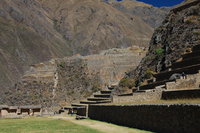
Our last stop before Machu Picchu was Ollantaytambo. It is known to the locals as Ollanta (well you would, I guess). It is located at the head of what's known as the Sacred Valley and, for us, was a couple of hours crazy minibus ride from Cusco. It is a jolly little town with narrow cobbled streets and cheerful Inca water conduits babbling away. Rather curiously, the water conduits are devoid of water at night when most of the tourists have left. Someone must be in charge of the Inca stop-tap. We spent a day or so here checking out some more Inca ruins including the most impressive Ollantaytambo fort and the free Pinkaulluna. We figured Pinkaulluna is free since it's approach is via a treacherous and vertiginous path up the vertical face of a mountain on the edge of town - too much responsibility for the local council!
Manco Inca fled to Ollantaytambo when he was overrun at Sacsayhuamán by the conquistadors. They didn't give up and sent a force to oust him from here too. Manco managed to successfully defend the fort (for a while). At one point, he rather ingeniously diverted water and bogged the Spanish down in the valley below and they retreated. Sadly however, the conquistadors returned shortly after with a load more men and thrashed the Incas, as was their want. At this point Manco Inca legged it again; this time into the jungle to Vilcabamba.
We spent a pleasant day wandering the ruins here marvelling at the intricate water irrigation system and again at the finely hewn stone blocks. Really, no one knows how they managed to engineer the stone so accurately. It is known that the quarry was located 6km away from the fort. At one point, the stone blocks had to be moved across the Urubamba river. The Inca solution? Pile all the blocks up on the river bank and then divert the river around the other side of them. Hey presto! Clever guys, but they still didn't have guns!
Ollantaytambo is where the train leaves from for Aguas Calientes which is the entry point to Machu Picchu. We have tickets for that train.
